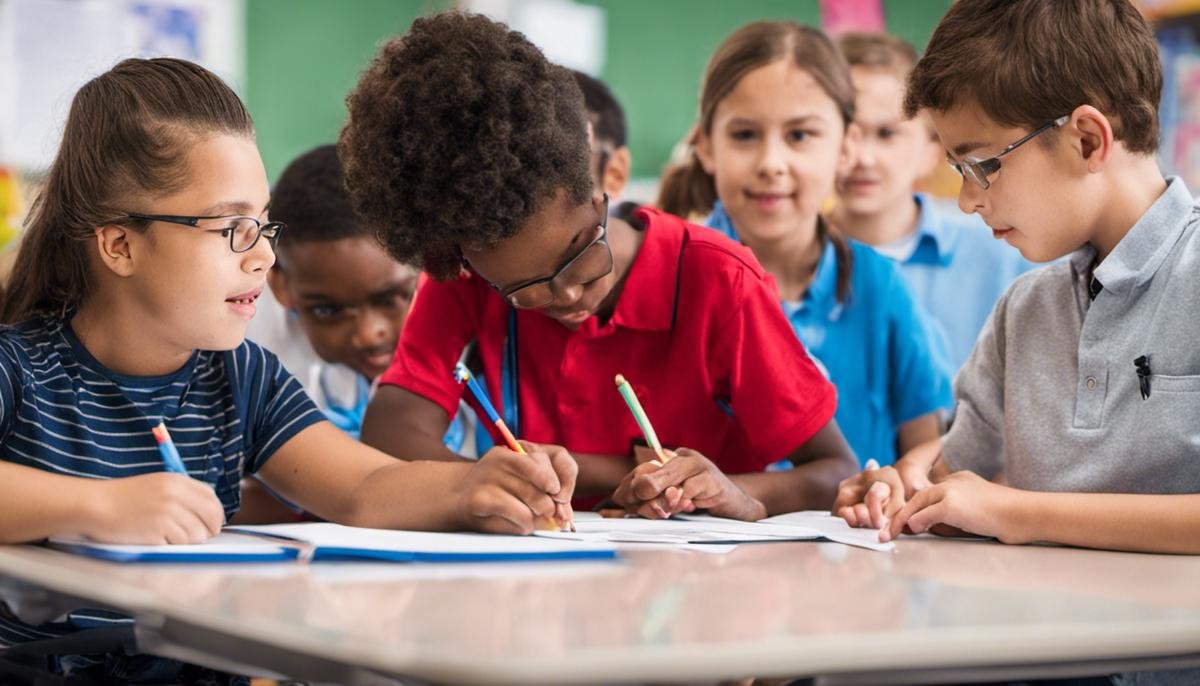
In a society that embraces diversity and inclusivity, it’s paramount to equip ourselves with the knowledge and skills to accommodate students with different learning needs. Among these, students with autism spectrum disorder (ASD) hold a significant place, necessitating a specialized pedagogical approach. In this context, understanding Autism’s impact on learning becomes the cornerstone of designing effective teaching strategies. Not only does this knowledge highlight the cognitive and social challenges faced by these students, but it also provides the foundation for developing a tailored Individualized Education Plan (IEP). By deeply analyzing and comprehending the unique requirements of autistic students, educators can foster an inclusive learning environment and optimize their educational attainment.
Understanding Autism’s Impact on Learning
Understanding Autism: Its Impact on a Student’s Cognitive and Social Development
Unraveling the factors that shape our children’s cognitive and social development can sometimes feel like navigating through an intricate labyrinth; it’s even more complex when your child is on the autism spectrum.
Autism is not a one-size-fits-all condition. Each child is unique, and the effects of autism on their cognition and social skills can largely differ. By understanding its effects, both educators and parents can effectively support and nourish their child’s growth.
When it comes to cognitive development, children with autism may face unique challenges, but they also possess remarkable abilities. A common misbelief is that all children with autism have intellectual disabilities. However, many exhibit average to above-average intelligence, with some showcasing remarkable skills and talents in areas such as mathematics, memory tasks, or in the arts.
Despite these cognitive strengths, children with autism may struggle with executive functioning – a set of mental skills encompassing attention, memory, impulse control, and flexible thinking. These skills are vital for tasks such as following instructions or dealing with changes in routine. As parents and teachers, it’s pivotal that we embed tools into their day-to-day schedule to assist with strengthening these skills.
Autism’s impact on a child’s social development can be notably apparent. Often, children with autism have difficulty interpreting social cues, understanding emotions (their own and others’), expressing empathy, and in forming social connections. This can lead to feelings of isolation, frustration, or confusion. In these circumstances, remember that it’s essential they feel our patience, understanding, and acceptance.
A key approach to supporting a child with autism in their social development is through their interests. Children with autism often have deep, passionate interests in specific topics. Encouraging socialization around these interests can provide a scaffold for them to build relationships, while also giving them something familiar to be comfortable with.
Another tried and tested method is using social stories and role-playing activities. These strategies allow children with autism to understand and practice varying social scenarios in a safe and controlled environment. This hands-on approach bridges the gap between theory and practical application, which can be incredibly useful for children on the spectrum.
Ensuring your child — or students — cultivate their cognitive and social skills requires celebration of their talents, and understanding that they might need support in areas that cause them difficulty. Remember that every child’s journey through autism is unique, and what works for one may not necessarily work for another. Patience and understanding are key, provided hand-in-hand with applicable strategies and tools.
The alleged complexity of autism should not forewarn us, rather it should foster the comprehension that each of these children are remarkable and unique in their own ways. By bolstering their potentials and nurturing their struggles, we ensure that every child feels respected, supported, and loved. The mark of any successful community is by the manner in which it cherishes and elevates its most vulnerable members. We can indeed craft such a community, one interaction at a time.

Individualized Educational Plan (IEP) for Autism
Crafting the Ideal Individualized Education Program (IEP) for a Student with Autism
In the beautiful adventure that is rearing a child with autism, one of the best tools families and educators have is the Individualized Education Program (IEP). This legally binding document outlines a child’s learning needs, the services the school will provide, and how progress will be measured. However, what does it mean to develop an effective IEP for a child with autism? Let’s delve into that today!
Setting clear communication goals is our first stop. Language development and communication can be one of the more challenging areas for children with autism. An effective IEP will address this by creating explicit communication goals tailored to the child’s unique needs. These could range from improving non-verbal cues, enhancing conversation skills, to working on subtle nuances within language.
Next up is sensory integration. Many children with autism perceive the world more intensely than others. Bright lights, loud noises, or even certain textures can feel overwhelming. The IEP should detail accommodations to help the child manage their sensory responses, such as a calm space to retreat to, or permission to use sensory tools such as stress balls or fidget spinners.
Another point worth considering is academic support. Students with autism often have specific learning styles that differ from the norm, and they may struggle with certain subjects. An effective IEP will offer supports like extra time for tests, use of assistive technology, or alternative educational materials accommodating the child’s unique learning style.
We then move into the realm of behavioral plans. Some children with autism may exhibit challenging behaviors, from aggression to repetitive actions or obsessive interests. Developing a positive behavioral plan within the IEP helps manage these behaviors and potentially redirects them into productive traits. The behavioral plan works best when it seeks understanding of the root causes of behaviors and sets clear, measurable objectives.
Finally, life skills training cannot be overlooked. Many students with autism need support to develop the skills necessary for independent living. An IEP should include goals to help the child learn these important skills – be it cooking, doing laundry, or even self-care practices like brushing teeth and bathing.
Getting an IEP that is personalized, comprehensive, and effective can feel like a daunting task, but remember, parent, you are your child’s greatest advocate! Make sure that you collaborate closely with the school and IEP team, and don’t be afraid to ask for adjustments based on your child’s needs.
Creating the most effective IEP for a student with autism is all about understanding that student’s distinct needs, abilities, and potential. It requires flexibility, persistence, and above all, an unwavering belief in their capabilities. Together, we can build an inclusive educational environment where every child has the opportunity to shine!

Inclusive Learning Environment for Autism
“Empowering Autistic Students: Strategies for Creating an Inclusive Classroom Environment”
As educators, our mission is to create a learning environment of acceptance, understanding, and inclusivity for every student we teach. This can be especially challenging when it comes to meeting the needs of students with a diverse range of abilities. Building an inclusive classroom for autistic students requires a special level of commitment and effort.
Foremost among these efforts is the establishment of clear communication goals. Students with autism may experience differences in how they give, receive and interpret information. It’s crucial to construct a communication framework suited to the child’s individual needs. The use of visual aids, social cues, and tailored verbal instructions can be immensely beneficial. Teachers should strive to be consistent in their communication, helping students feel secure and confident in their understanding.
Equally important is addressing sensory integration challenges that are common in autistic students. These students can be hypersensitive to their surroundings, or might struggle to process sensory information. Managing classroom noise levels, allowing for movement breaks, creating “quiet corners,” and carefully considering classroom lighting are just some ways to make the classroom more sensorily friendly.
In terms of academic support, teachers should focus on leveraging the student’s interests and strengths. Use differentiated instruction methods that accommodate different learning styles. For instance, a child who is a visual learner might benefit from tasks that involve pictures, diagrams or videos. Concrete examples can often be more effective than abstract concepts.
Developing consistent and proactive behavioral plans are essential in an inclusive classroom. These plans can help autistic students navigate social scenarios, manage their emotions, and mitigate potential disruptive behaviors. Set clear, realistic expectations and continuously reward positive behaviors.
Life skills training should also be incorporated alongside the academic curriculum. Helping autistic students master everyday activities like personal hygiene, basic cooking, or navigating public transportation can boost their independence and self-esteem.
Collaboration plays a pivotal role in creating an inclusive environment. Teachers should foster a strong relationship with the Individualized Education Program (IEP) team. This team, which includes parents, therapists, counselors, and other care providers, helps customize academic frameworks suited for the student’s unique needs.
While personalizing the IEP, it’s imperative to center it around the student’s specific interests and strengths. At the same time, it should address the student’s areas of development with a focus on strategies that facilitate growth. Teachers should also ensure that the IEP is flexible, allowing for necessary modifications as the student grows and evolves.
Finally yet importantly, belief in every student’s capabilities, regardless of their abilities or challenges, is the cornerstone of an inclusive classroom. Autistic students, like any other kids, want to feel accepted, understood, and appreciated. Maintain a high expectation for your autistic students. And remember – every small step of progress is a victory to be celebrated!
Empowering autistic students to succeed in an inclusive classroom environment requires patience, empathy, and plenty of creativity. However, the reward – witnessing the growth and development of these extraordinary students – is genuinely priceless. Practice these strategies and create a warm, nurturing classroom where every student feels valued, understood, and supported.

The realm of education requires continuous adaptation to meet the evolving needs of every student. Creating a holistic learning experience for students with autism is a task that involves multiple layers – understanding their learning hurdles, crafting an effective IEP that addresses these challenges, and building an embracing atmosphere that fosters their growth. Equipped with this knowledge, teachers, parents, and communities can work collaboratively to build a bright future for autistic learners. Ultimately, the success of these initiatives rests on our collective shoulders, encouraging us to learn, grow, and develop more effective educational strategies for our next generation.




